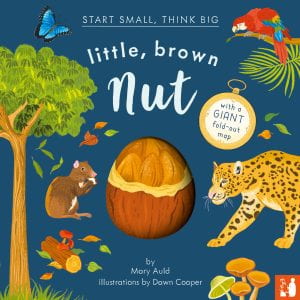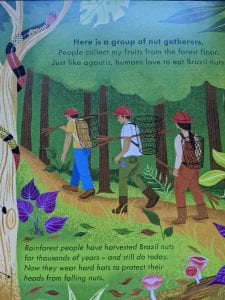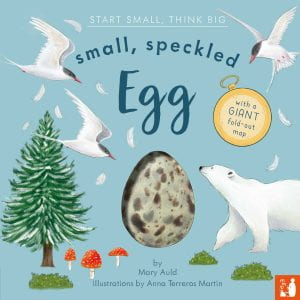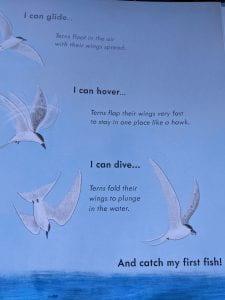It is always a delight to welcome a new publisher to the world of children’s books, so I am very happy to be asked to take part in this blog tour for the relatively young publisher ‘Mama makes Books‘, which started in 2020. They are celebrating the launch of the first two titles in a new series called “Start Small, Think Big“. This is a series of factual books aimed at the young newly confident reader, but which can be shared with those who are slightly younger. The launch of these titles also celebrates the fact that this is National Non-Fiction November.
As someone who has been involved with Information books over many years (it is a lot, I promise you) I am thrilled by the wonderful books that are being produced today. These two beauties are no exception and they really do focus the attention from the moment you catch sight of the covers. Physically the books are just the right size for a child to hold and the number of pages (18, +foldout) means that they are not tiring for the reader. I particularly love the use of a cut-out on the front cover, so that the reader is instantly drawn in to the inside pages.
 “Little, Brown Nut” by Mary Auld and Dawn Cooper takes us into the magical world of the Amazonian rainforest, where we follow the life cycle of the Brazil nut. Until now I had only thought of these nuts in relation to Christmas and tins of chocolates! However, their life cycle is absolutely fascinating and particularly the fact that the Agouti is one of the only animals that is able to actually crack the shell of the nut. This led me on to wonder whether the animals are endangered by the loss of rainforest and what impact that would have on the nut trees. Luckily the
“Little, Brown Nut” by Mary Auld and Dawn Cooper takes us into the magical world of the Amazonian rainforest, where we follow the life cycle of the Brazil nut. Until now I had only thought of these nuts in relation to Christmas and tins of chocolates! However, their life cycle is absolutely fascinating and particularly the fact that the Agouti is one of the only animals that is able to actually crack the shell of the nut. This led me on to wonder whether the animals are endangered by the loss of rainforest and what impact that would have on the nut trees. Luckily the book explains about the ‘castaneros’; these are natives of the Amazon who harvest the nuts, whilst also maintaining and protecting the trees from the large logging companies. I love the vibrant use of colour in the illustrations, which seem to perfectly reflect the vivid and wide ranging vegetation and animal life in the environment.
book explains about the ‘castaneros’; these are natives of the Amazon who harvest the nuts, whilst also maintaining and protecting the trees from the large logging companies. I love the vibrant use of colour in the illustrations, which seem to perfectly reflect the vivid and wide ranging vegetation and animal life in the environment.
“Small, Speckled Egg” by Mary Auld and Anna Terreros Martin is set in a totally different part of the world and shows us the life cycle of an Arctic tern. These beautiful birds live in some of the harshest environments that you can imagine and they are the target for a wide range of creatures, from polar bears to seagulls and foxes. The illustrations for this book are absolutely beautiful and show the life process, from the egg to the moment when the new terns follow their parents as the migrate south in the autumn. There is a delicacy in the line drawings and the subdued use of colour, which really emphasizes the world that these birds live in. I particularly love one page, where the bird shows how it can glide, hover and dive; the illustrator has managed to really capture these movements, especially the hovering.
of the world and shows us the life cycle of an Arctic tern. These beautiful birds live in some of the harshest environments that you can imagine and they are the target for a wide range of creatures, from polar bears to seagulls and foxes. The illustrations for this book are absolutely beautiful and show the life process, from the egg to the moment when the new terns follow their parents as the migrate south in the autumn. There is a delicacy in the line drawings and the subdued use of colour, which really emphasizes the world that these birds live in. I particularly love one page, where the bird shows how it can glide, hover and dive; the illustrator has managed to really capture these movements, especially the hovering.
 A feature of this series is that the final page layout consists of a foldout , which expands into a map and shows not only the migration of the birds and the location of the rain forests, but also gives information to further our knowledge of the areas. Because these books are aimed at a young age group and do not have a huge number of pages, they do not have any of the added extras such as index or glossary. However, these are books that are going to work perfectly on a one to one basis, both in school and at home. They are full of information, but can also be read as narrative non-fiction, where the story is just as important.
A feature of this series is that the final page layout consists of a foldout , which expands into a map and shows not only the migration of the birds and the location of the rain forests, but also gives information to further our knowledge of the areas. Because these books are aimed at a young age group and do not have a huge number of pages, they do not have any of the added extras such as index or glossary. However, these are books that are going to work perfectly on a one to one basis, both in school and at home. They are full of information, but can also be read as narrative non-fiction, where the story is just as important.
These books are delightful and have raised high expectations for future titles in the series. They really need to find a home in every primary school.
